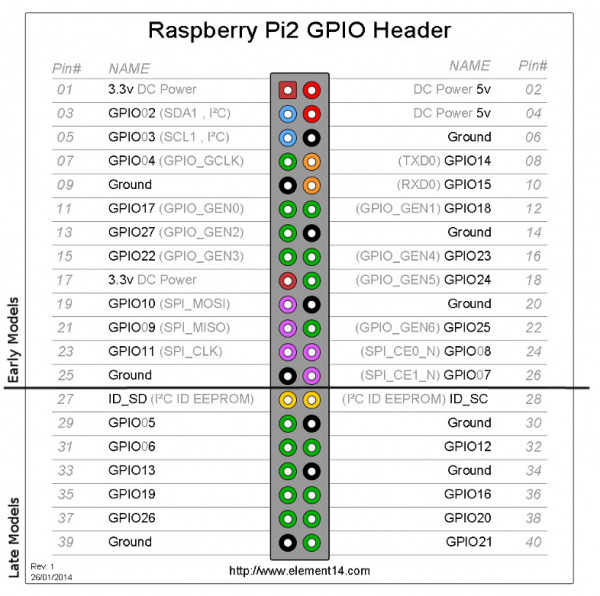Raspberry gPIo
GPIO Pinout
The Raspberry Pi offers up its GPIO over a standard male header on the board. Over the years the header has expanded from 26 pins to 40 pins while maintaining the original pinout.
If you're coming to the Raspberry Pi as an Arduino user, you're probably used to referencing pins with a single, unique number. Programming the Pi's hardware works much the same, each pin has its own number...and then some.
There are (at least) two, different numbering schemes you may encounter when referencing Pi pin numbers: (1) Broadcom chip-specific pin numbers and (2) P1 physical pin numbers. You're usually free to use either number-system, but many programs require that you declare which scheme you're using at the very beginning of your program.
Here's a table showing all 26 pins on the P1 header, including any special function they may have, and their dual numbers:
| Wedge Silk | Python (BCM) | WiringPi GPIO | Name | P1 Pin Number | Name | WiringPi GPIO | Python (BCM) | Wedge Silk | |
| 3.3v DC Power | 1 | 2 | 5v DC Power | ||||||
| SDA | 8 | GPIO02 (SDA1, I2C) | 3 | 4 | 5v DC Power | ||||
| SCL | 9 | GPIO03 (SCL1, I2C) | 5 | 6 | Ground | ||||
| G4 | 4 | 7 | GPIO04 (GPIO_GCLK) | 7 | 8 | GPIO14 (TXD0) | 15 | TXO | |
| Ground | 9 | 10 | GPIO15 (RXD0) | 16 | RXI | ||||
| G17 | 17 | 0 | GPIO17 (GPIO_GEN0) | 11 | 12 | GPIO18 (GPIO_GEN1) | 1 | 18 | G18 |
| G27 | 27 | 2 | GPIO27 (GPIO_GEN2) | 13 | 14 | Ground | |||
| G22 | 22 | 3 | GPIO22 (GPIO_GEN3) | 15 | 16 | GPIO23 (GPIO_GEN4) | 4 | 23 | G23 |
| 3.3v DC Power | 17 | 18 | GPIO24 (GPIO_GEN5) | 5 | 24 | G24 | |||
| MOSI | 12 | GPIO10 (SPI_MOSI) | 19 | 20 | Ground | ||||
| MISO | 13 | GPIO09 (SPI_MISO) | 21 | 22 | GPIO25 (GPIO_GEN6) | 6 | 25 | G25 | |
| CLK | (no worky 14) | GPIO11 (SPI_CLK) | 23 | 24 | GPIO08 (SPI_CE0_N) | 10 | CD0 | ||
| Ground | 25 | 26 | GPIO07 (SPI_CE1_N) | 11 | CE1 | ||||
| IDSD | 30 | ID_SD (I2C ID EEPROM) | 27 | 28 | ID_SC (I2C ID EEPROM) | 31 | IDSC | ||
| G05 | 5 | 21 | GPIO05 | 29 | 30 | Ground | |||
| G6 | 6 | 22 | GPIO06 | 31 | 32 | GPIO12 | 26 | 12 | G12 |
| G13 | 13 | 23 | GPIO13 | 33 | 34 | Ground | |||
| G19 | 19 | 24 | GPIO19 | 35 | 36 | GPIO16 | 27 | 16 | G16 |
| G26 | 26 | 25 | GPIO26 | 37 | 38 | GPIO20 | 28 | 20 | G20 |
| Ground | 39 | 40 | GPIO21 | 29 | 21 | G21 | |||
This table shows the Pi pin header numbers, element14 given names, wiringPi numbers, Python numbers, and related silkscreen on the wedge.
As you can see, the Pi not only gives you access to the bi-directional I/O pins, but also Serial (UART), I2C, SPI, and even some PWM ("analog output").

